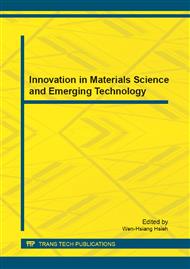p.349
p.354
p.359
p.364
p.369
p.374
p.379
p.384
p.390
Graphic Representation and Cognition Diagnosis on Concepts of Linear Algebra
Abstract:
The purpose of this study is to integrate pathfinder and item response theory so as to manage concept structures. Concept structure is one important issue of knowledge management as to human knowledge storage. Pathfinder and item response theory are based on graph theory and psychometrics respectively and this integrated method should be feasible to represent concept structures. Besides, fuzzy clustering technique is adopted to provide features of concept structures based on homogeneity of sample. In this study, the empirical data is the assessment of linear algebra for university students. The important concepts of linear algebra consist of subspace, spanning, linear independent, R2 and R3 and many literatures indicate concept structures of linear algebra will influence advanced mathematics. However, little is known about the concept structure and cognition diagnosis on linear algebra. In this study, it shows that lack of concrete examples in general dimensional space will prevent the development of the general theory. There are some limitations for students to use some materials to clarify complicated mathematic concepts perfectly. Most students could not be able to use the geometric insight and apply the Pythagorean of R2 or R3. It shows that methodology of the pathfinder and item response theory will reveal important information of concept structures for students. In addition, fuzzy clustering could distinguish characteristics of concept structures on linear algebra. Finally, some limitations and suggestions as to this study are discussed.
Info:
Periodical:
Pages:
369-373
Citation:
Online since:
December 2011
Authors:
Price:
Сopyright:
© 2012 Trans Tech Publications Ltd. All Rights Reserved
Share:
Citation:


